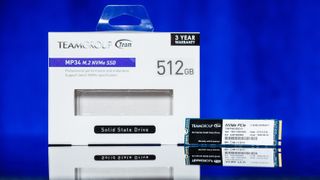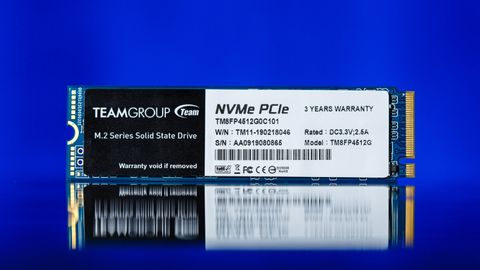Tom's Hardware Verdict
Team Group’s MP34 is a fairly ordinary Phison E12 based SSD, but it comes into the market at impressive prices while offering high-end performance and robust endurance. If you're in the market for a budget NVMe SSD, this is one that deserves to be on your short list.
Pros
- +
Solid performance
- +
High endurance rating
- +
Competitive prices
Cons
- -
Blue PCB
- -
3-year warranty
Why you can trust Tom's Hardware
One Fast Cookie Cutter SSD
Team Group’s M.2 NVMe MP34 is one of the hottest values out in the SSD market today. At just $0.15-$0.16 per GB, it's one of the cheapest Phison E12-powered SSDs we’ve seen. While it lacks originality, it will definitely help to bring your system up to speed, alongside some of the best. Great performance mixed with very competitive pricing makes the MP34 a killer value. That said, low pricing also comes with a lack of accessories and a rather short 3-year warranty.

In many ways, Team Group’s MP34 isn’t all that special. There’s no flashy RGB lighting or included heatsink. In short, it's just another cookie cutter Phison E12 design with Toshiba's BiCS3 TLC NAND flash. The main difference we see between it and others is that the Team Group drive utilizes DDR3L DRAM instead of DDR4. Interestingly enough, it doesn’t hinder the MP34’s performance, nor does the fact that it doesn’t have much factory over-provisioning. As a matter of fact, the MP34 actually trades blows with the MyDigitalSSD BPX Pro, which has DDR4 DRAM and is over-provisioned.
This brings up the question: Just how much does over-provisioning matter to most consumers? From our experience, the answer is not a whole lot. Usually, the controller will still be able to utilize the free space for garbage collection and other background tasks without issue. It only becomes a problem if you fill the drive all the way up or pound it with the heaviest of workloads, like the stuff you would see going on in servers.
Loading games, office productivity, and browsing the web hardly qualify as taxing workloads in the least for most SSDs. Even heavier use cases such as using it as a cache device for 4K media production and virtual machine hosting won’t slow this bad boy down much at all. So, without any extra overprovisioning, end users still get great performance as well as a bit of extra capacity to boot.
Specifications
| Product | MP34 256GB | MP34 512GB | MP34 1TB |
| Pricing | $41.99 | $74.99 | $159.99 |
| Capacity (User / Raw) | 256GB / 256GB | 512GB / 512GB | 1024GB / 1024GB |
| Form Factor | M.2 2280 | M.2 2280 | M.2 2280 |
| Interface / Protocol | PCIe 3.0 x4 / NVMe 1.3 | PCIe 3.0 x4 / NVMe 1.3 | PCIe 3.0 x4 / NVMe 1.3 |
| Controller | Phison E12 | Phison E12 | Phison E12 |
| DRAM | NANYA DDR3L | NANYA DDR3L | NANYA DDR3L |
| NAND Flash | Toshiba BiCS 3 64L TLC | Toshiba BiCS 3 64L TLC | Toshiba BiCS 3 64L TLC |
| Sequential Read | 2,700 MB/s | 3,000 MB/s | 3,000 MB/s |
| Sequential Write | 850 MB/s | 1,700 MB/s | 2,600 MB/s |
| Random Read | 190,000 IOPS | 190,000 IOPS | 180,000 IOPS |
| Random Write | 160,000 IOPS | 160,000 IOPS | 160,000 IOPS |
| Encryption | AES-256 / TCG Pyrite | AES-256 / TCG Pyrite | AES-256 / TCG Pyrite |
| Endurance | 380 TBW | 800 TBW | 1660 TBW |
| Part Number | TM8FP4256G0C101 | TM8FP4512G0C101 | TM8FP4001T0C101 |
| Warranty | 3-Years | 3-Years | 3-Years |
Team Group’s MP34 is available in capacities of 256GB, 512GB, and 1TB. At the time of this writing, those capacities are priced at $42, $75, and $160 respectively. At prices like this, there should be no excuse to use an HDD for your OS ever again.
Team Group hugely underrates the device’s performance. They state it is only good for up to 3GB/s read and 1.7GB/s. However, in our testing it performed just like the rest of our E12 based samples; up to 3.5/2.1GB/s read/write. Random performance is also hugely underrated. The drive is rated for up to 190K/160K IOPS, but our 512GB sample delivered over 300,000/485,000 IOPS read/write at a QD of 64.
Where the company didn’t underrate this drive was in respect to write endurance. While high-end SSDs like the Samsung 970 EVO Plus and WD Black SN750 are rated for up to 300TB written at the 500GB capacity, the budget-friendly MP34 is rated for almost triple that, up to 800TBW. The 1TB option is even rated for over 1.6 petabytes written. With high endurance like this, what’s not to love? Well, there’s a catch. While it is rated for higher endurance, it comes with warranty coverage of just three years, while most premium, speedy drives in this class are covered for five years.
Software and Accessories




Team Group, like many others, offers end users support via an optional SSD Toolbox download as well as an NVMe driver, both for Windows 7-10. With the toolbox, you can monitor the SSD’s S.M.A.R.T. data and lifespan. It even has data migration built in, but that option is only for use with SATA SSDs as per the support document. So in testing with this drive, we were unable to use it, just as expected.
A Closer Look
Team Group’s MP34 comes in an M.2 2280 form factor which utilizes a PCIe 3.0 x4 connection to the host and communicates via the NVMe protocol. Our 512GB sample is single-sided, meaning it only has components on one side of the PCB.






The PCB itself is blue and the sticker on top is rather unappealing aesthetically. This is to be expected of a cheaper SSD, but better looks with a black PCB would have earned it a few more brownie points. As mentioned earlier, it features Phison’s E12 NVMe controller and Toshiba BiCS3 64L TLC NAND flash as well as a single DDR3L DRAM package for caching the device’s file translation layer.
MORE: Best SSDs
MORE: How We Test HDDs And SSDs
MORE: All SSD Content

Sean is a Contributing Editor at Tom’s Hardware US, covering storage hardware.
-
Giroro The drive 476.94 GB to the user, not the 512GB for the "user" in the table.Reply
If their software actually meant, 476.94 GiB, then it why isn't using the correct unit of measurement?
More needs to be done to call out manufacturers on their false advertising on SSD capacities, or at least to educte customers that the numbers on the box don't really mean anything anymore. -
80-watt Hamster ReplyGiroro said:The drive 476.94 GB to the user, not the 512GB for the "user" in the table.
If their software actually meant, 476.94 GiB, then it why isn't using the correct unit of measurement?
More needs to be done to call out manufacturers on their false advertising on SSD capacities, or at least to educte customers that the numbers on the box don't really mean anything anymore.
This is not new. Drive capacity has been measured in multiples of 1000 rather than 1024 for decades. -
Giroro Reply80-watt Hamster said:This is not new. Drive capacity has been measured in multiples of 1000 rather than 1024 for decades.
I am aware of that. Just because it isn't new, doesn't mean we all have to continue to sit by and accept deceptive marketing until the end of time.
Every time we go up in capacity, the difference between the marketing and reality grows larger. -
seanwebster Reply
+180-watt Hamster said:This is not new. Drive capacity has been measured in multiples of 1000 rather than 1024 for decades.
GiB is the correct unit of measurement within Windows, but in my experience, many people confuse GB and GiB, so I usually just go with GB to reduce confusion when reporting Windows usable capacity even though it is technically GiB.
Manufacturers sell drives at a power of 1000 while Windows calculates drives as powers of 1024.
512GB, 500GB, and 480GB capacity SSDs usually all have the same RAW NAND capacity of 512GiB or 549,755,813,888 bytes. Manufacturers overprovision a bit from factory for wear leveling, garbage collection, bad block management, etc. Factory over provisioning varies per device but with our example of 512GB, 500GB, and 480GB SSDs, this means that a drive goes from a usable RAW capacity of 512GiB or 549,755,813,888 bytes to 512GB / 512,000,000,000 bytes, or 500GB / 500,000,000,000 bytes, or 480GB / 48,000,000,000 bytes, which is what the manufacturer sells them as. Windows then reports those capacities as a power of 1024, which converts to ~477GiB / 476,837,158,203 bytes, ~466GiB / 465,661,287,308 bytes, or ~447GiB / 447,034,835,815 bytes.
We report the User capacity / Raw capacity in GB on our charts as to not get people too confused about the whole GiB thing, but I like to include what Windows reports anyways just because to me, it matters since that is what I'm working with within my Windows OS. Other OSes report the capacity in GB, not GiB. -
Mr Marshall Thank you for the quick, to the point, and easily understood article. I personally do not find it being blue PCB being much of an issue. As for me, as long as it isn't green I wouldn't list it as a con. Also, I agree that bringing up the entire argument of listed capacities etc. is beating a dead horse at this point by consumers. I do, however, have a question. If the drive is relatively filled let us say 70-80% does this affect the performance a lot especially when gaming? Sure maybe it isn't as noticeable now with a lack of over-provisioning (theoretically, not sure if you tested this or just an assumption) but I am thinking more in the near future with games going entirely to depend on SSDs of many forms.Reply -
seanwebster Reply
It shouldn't affect read performance at all in your application...gaming is nearly all reads. Nor should that affect write performance since the SLC cache is a static size. All my testing is done with the SSD being used as the OS drive and 50% full as it is. (except the 15minutes write test which is done after a secure erase.)Mr Marshall said:Thank you for the quick, to the point, and easily understood article. I personally do not find it being blue PCB being much of an issue. As for me, as long as it isn't green I wouldn't list it as a con. Also, I agree that bringing up the entire argument of listed capacities etc. is beating a dead horse at this point by consumers. I do, however, have a question. If the drive is relatively filled let us say 70-80% does this affect the performance a lot especially when gaming? Sure maybe it isn't as noticeable now with a lack of over-provisioning (theoretically, not sure if you tested this or just an assumption) but I am thinking more in the near future with games going entirely to depend on SSDs of many forms.
70-80% full won't make much of a difference. The only time it does is when drives feature dynamic caches. They will have a smaller SLC write cache when fuller with data, although many also have a static SLC cache in place to guarantee high burst write performance, which is plenty for most consumer applications. -
davrob01 Team Group has recently extended the warranty on this SSD model to 5 years. Making it an even better deal!Reply
Sources:
https://www.teamgroupinc.com/en/product/mp34
https://www.amazon.com/TEAMGROUP-MP34-512GB-Solid-TM8FP4512G0C101/dp/B07PHMJR4Y
